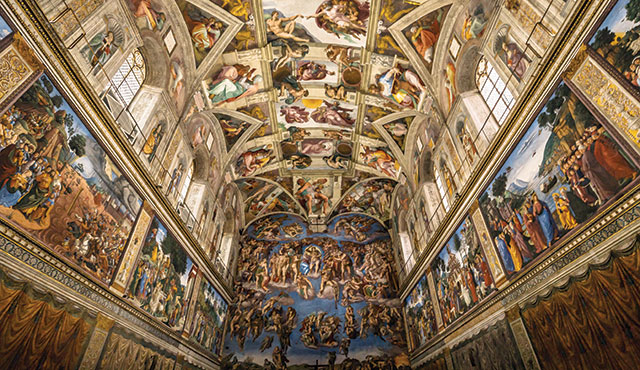“I am commissioning you to complete my uncle Sixtus’ chapel by painting the ceiling,” a matter-of-fact Pope Julius II tells a stunned Michelangelo in the Irving Stone novel, “The Agony and the Ecstasy.” There is a great shot in the 1965 Hollywood movie adaptation of the novel at this moment. Michelangelo (Charlton Heston) knows what Pope Julius (Rex Harrison) is ordering is no small task. As his petrified eyes reluctantly gaze up to the emptiness of the vaulted ceiling 68 feet above him, the camera follows Michelangelo’s gaze, craning upwards as it pans over the vastness and enormity of the canvas now put before the artist by the pope himself.
Michelangelo tried to wiggle his way out. “I am a sculptor, not a painter!”
Originally, Pope Julius wanted representations of the Twelve Apostles depicted on the ceiling, which at that point was an unattractive blue, dotted with gold stars. In Stone’s novel, Michelangelo realizes the Twelve Apostles were not for pious or artistic reasons, but to disguise the ugliness of the Sistine Chapel ceiling. Michelangelo humbly acknowledges in that instant he is not hired for the sake of his artistry, but to be a decorator.
Nevertheless, committed to his craft and loyal to his benefactor, Michelangelo set out to work, but something was missing, and Michelangelo knew it. The assignment lacked that inherent spark an artist needs to make something great. If Julius simply wanted something to fill the space, he certainly did not lack available talent. Raphael, for instance, younger and more delicate than Michelangelo, was always nearby waiting for the pope’s beck and call. And Michelangelo, now in his mid-30s, was frustrated by both the physical discomfort of working on his back, ultimately affecting his eyesight, and his lack of zeal for the whole affair.
But it was Michelangelo and nobody else who conceived what the Sistine Chapel ultimately is best known for: the story of creation. In “The Agony and the Ecstasy,” Michelangelo’s moment of inspiration occurs on New Year’s Day, 1509, as he watches the sunrise from the mountains of Tivoli, just outside Rome. From this vantage, an idea grabs hold of him…the Book of Genesis, its story of humanity’s greatness and downfall told as a series of panels. “What a magnificent artist was God when He created the universe: sculptor, architect, painter: He who originally conceived space, filled it with His wonders,” he thinks in that moment.
When an artist is seized by such a grand idea, time stops. There is no thought of budget, feasibility, all of the monumental effort and toil that looms ahead. When an idea as big, as bold, and as seemingly impossible as the themes in the Sistine Chapel manifest themselves, the artist’s adrenaline soars. The thought of being out of one’s depth, of failure, and of success all surge at the same time. When something so grandiose is hatched, for Michelangelo it would be more painful to abandon it than to see it through.
Once this ownership of painting the Sistine Chapel ceiling seized Michelangelo, there was no turning back. It took four more years, but the result of that moment of inspiration is what we continue to admire today, from God’s creation of the world through the rise and fall of Adam and Eve–in all, over 340 characters appear on the ceiling. And it was Michelangelo alone who saw it through to the end, even well after the initial euphoria faded. Others have the luxury to move on with their lives, indifferent to whether a creative idea is realized or not. Artists cannot let go, until they know the work before them is complete. “When will it be ready?” Pope Julius would ask again and again with mounting irritation. “When it is ready!” Michelangelo would reply every time.
When one feels a sense of ownership about something, of investment, the matter at hand is handled delicately and intimately. Like a job, a house, family responsibility. We might ask ourselves: do we have this same sense of ownership about our faith?
The central relationship in “The Agony and the Ecstasy” is the father-son dynamic between Julius and Michelangelo. Julius II, pope from 1503-1513, knew greatness when he saw it and ultimately left Michelangelo alone to labor in what proved to be yet another masterpiece. Yet his playful badgering of Michelangelo, as a parent might, is primarily not to discourage Michelangelo, but to motivate him to reach for the heights he is capable of attaining. When on All Saints’ Day, 1512, the day the completed ceiling was revealed to the public, in Stone’s novel Julius cannot help but give one more nudge: “Don’t some of the decorations need to be brightened with gold?”
“Those whom I have painted were poor,” said Michelangelo, breaking the silence. “They were holy men.”


